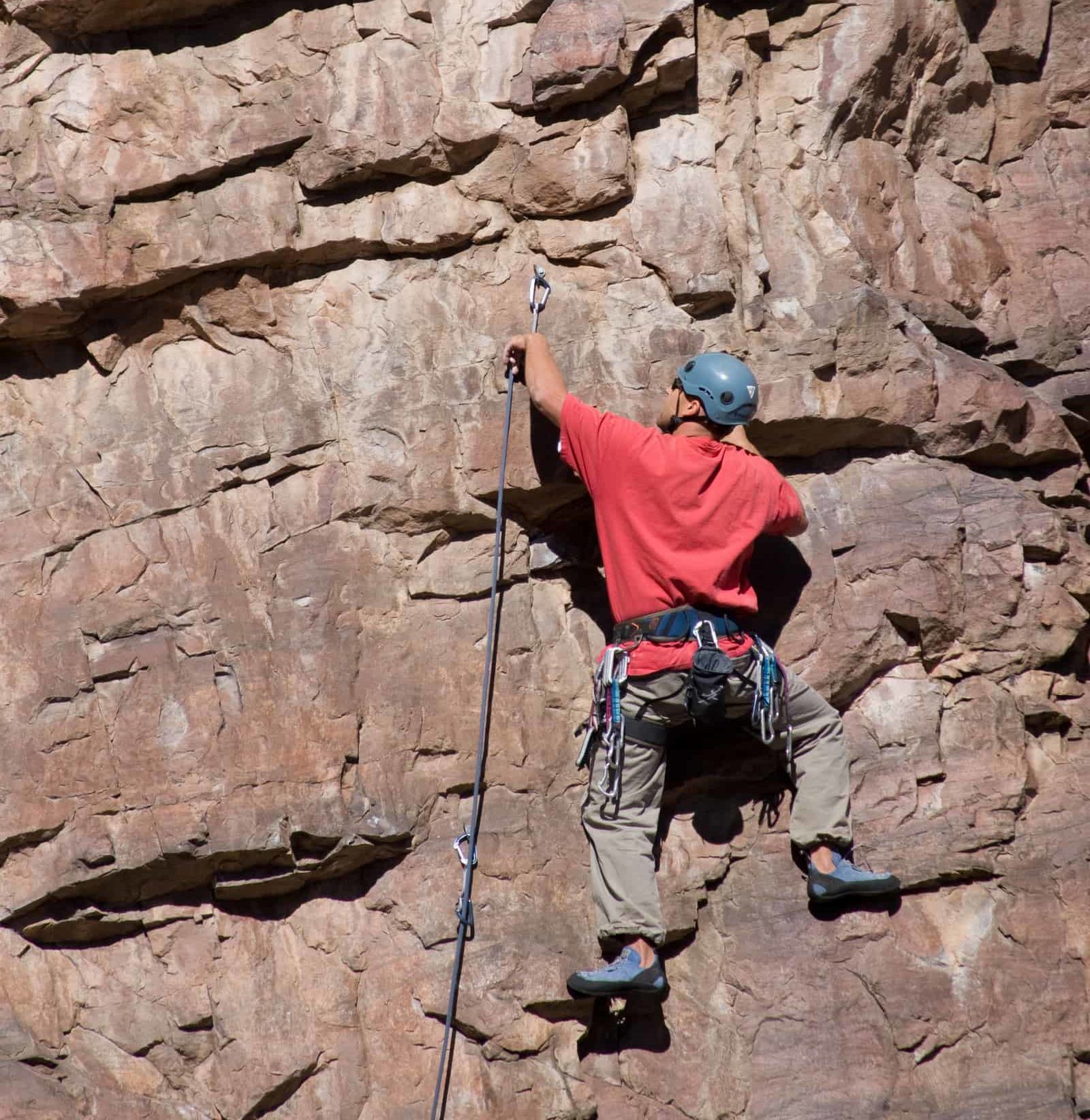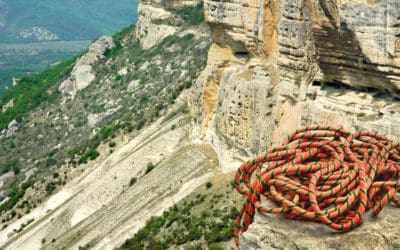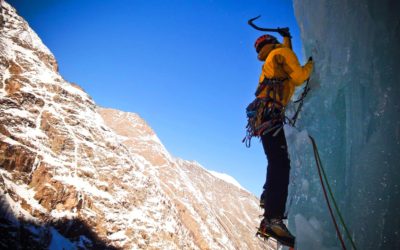
You’ve been climbing top rope for a while. It’s awesome, right? You get to try crazy moves without much consequence, since you’ll only fall as far as the rope stretches, unless your belayer messes up. But now, you’re starting to notice the drawbacks of top roping: the belay rope is sometimes in your way, making it tricky to get to those perfect handholds.
The main dangers of lead climbing are from falling, belaying, placing gear improperly, whippers and falling of rocks.
Also, venturing too far away from the vertical path set by the top rope has the rope tugging at your harness, pulling you off balance and messing up your perfect climb. Let’s face it, top roping is starting to feel like the kiddies ride and you’re ready for the next step.
So, just how dangerous is lead climbing, anyway? In this article, I’ll explore the dangers of lead climbing, along with ways to mitigate the risks and overcome the danger.
Contents
1. Clipping into the second Bolt and Falling
When you’re top roping, you won’t fall far. Lead climbing, however, is a whole different ball game.
Here, you’re being belayed from below while setting up protection points as you go up the route. These protection points are either permanent bolts that you clip into, or trad (traditional) gear, where you wedge removable crack-jamming devices into little crevasses in the rock.
If you fall while lead climbing, you will fall twice the distance that you’re away from your last protection point. So, if you’re 1 meter above your last bolt, you will fall 2 meters and some rope stretch. This is scary and potentially dangerous.
If you’re on a tricky route of lots of sharp edges jutting out, you could easily bang your head or other body part, leading to serious injury or death, especially if you’re not wearing a helmet.
The greatest risk is when you’re clipping into your second bolt. Here, you’re probably about 3 meters above the previous bolt, and you have some free rope out in order to clip. This means that, if you fall, you’re looking at just over 6 meters down, which is probably on the ground, so you’ll hit the deck.
The safest fall would probably be on an overhang, since you’re not likely to hit the ground. You could swing like a pendulum, though, which means banging into or scarping on the adjacent rock face. If you’re wearing a helmet, you’ll probably only get some scrapes. We call them cheese grater injuries.
2. The Belayer
Belaying ties directly into the falling hazard. Pick your belayer carefully. After all, you literally trust this person with your life.
Top rope belaying is very different from lead climb belaying. Your belayer should preferably not be a newby, especially if you’re new to lead climbing. You don’t need that added stress when you’re halfway up the rockface, about to try a risky move.
If your belayer is new to lead belaying, have an experienced lead belayer watch them and coach them through it.

3. Improper Gear Placement
When you’re lead climbing a trad route, it can be nerve wracking. Here, you’re hanging on with one hand, sometimes literally by a finger, while sifting through a full rack of gear to get the right tool for your next protection point. Then you still have to place the gear and bolt into it before you get a brief breather.
When you’re pumped and stressed on the wall, it’s easy to lose focus and place gear improperly.
If you fall on improperly placed gear, you could get seriously hurt, since the gear would most probably rip out of the crag you placed it in and you would fall way further than planned.
If you end up too close to the ground after a big fall like that, your belayer probably won’t have time to take in enough rope, which means that you end up hitting the ground. Hard.
Back Clipping
When you’re lead climbing, there’s a correct, and safe, way to clip into your next bolt.
When you clip the rope into the bottom carabiner, it should go away from the rock, not towards it.
If you fall when you’re back clipped, the rope could unclip from the carabiner, which means you would freefall to the ground.
Z-Clipping
This is when you’re clipping into your next bolt, but instead of using the rope that’s passing through your carabiner; you grab a section of rope from below your last bolt. This is common on routes where the bolts are placed close to each other.
Now, you’re not secured on the highest piece of protection, but effectively, you’re still secured on the previous bolt.
If you fall in this situation, you’ll fall double the distance between you and the previous bolt, which is a much greater distance and thus far more dangerous.
Toe Tuck
It’s super easy to accidentally get your leg behind the rope. This is called a toe tuck and happens when you’re already clipped into a bolt above where your feet are.
If you fall in this situation, you will spin a bit, slamming your body into the rock face.
4. Whippers
If the lead climber takes a very big fall and the load on the rope is significant, the belayer can get lifted off the ground, sometimes as far as the first bolt or protection point.
This is scary for both the climber and the belayer, especially if the belayer isn’t using a self-arresting belay device, like a grigri.
If the whipper is especially long, the climber could fall past the belayer. This is called teabagging.
5. Rock Falls
When you hit the crag, you run the risk of rock falls. In some areas, these are quite common, while not so much in others. Either way, since you’re in an uncontrolled environment, you should be aware of this risk.
If a large chunk of rock unexpectedly gives way and tumbles down, whoever is in its way will get seriously hurt and might die.
Managing the Risk
There are quite a few ways in which you can manage the risks of lead climbing. Here’s a brief overview:
Get Trained
If you’re contemplating lead climbing, it’s a good idea to go for a course at a reputable climbing school.
The instructors will educate you in lead climbing, ensuring that you have all the necessary skills and safety practices in order to do this successfully.
It’s also a good idea to hit the crags with an experienced climber. This way, you get to watch them at work, getting tips as you go along.
You could also second the experienced climber. This means that you belay them up the route, after which they belay you from above. Here, you would clean the route as you ascend, added another skillset as you go along.
In training, you will also learn how to fall properly, which will help you a lot when you’re out at the crag. Basically, you want to absorb the force of a fall on your leg.
In other words, don’t grab the rope, rather swing yourself so your side hits the rock face. Grabbing the rope will give you rope burn on your hand, or, if you grab too tightly and too high, could dislocate your shoulder. Not fun.
Know Your Limits
When you’re leading a route, especially if it’s a trad route, bump down your grade a bit.
Leading takes more energy than top rope climbing, so you won’t be able to last as long or do as technical a route as you would on a top rope.
Climbing a slightly easier route would help you conserve your energy and minimize the risk of falling and incorrect gear placement.
Also take into account that lead climbing requires you to carry a full rack of gear with you. This rack is heavy, putting added strain on your body and sapping your energy.
Conclusion
Lead climbing is incredibly rewarding and is definitely worth it. Before you head out, though, be sure to understand the dangers involved and get some proper training to prepare you for it.
Lead climbing can sound super scary, and it is, but luckily the mortality rate in rock climbing isn’t that high.
When you pick a route for lead climbing, take your skill level into account, along with your risk tolerance, making sure that the route is within your reach. It’s okay to pick a safer or easier route, especially when you’re starting out. While it’s good to push yourself, it’s no fun walking away from the crag with no successful route in your pocket.
Written by Felix

About me
Hi! I’m Felix. When I’m not spending time out in the mountains, I like to write about my hobbies. That is how Mountain Homies was created. On this site, I try to gather all the juicy information about Mountaineering that I have learned since I started. Happy adventures!
Related Articles
Mountain Climbing vs Rock Climbing: 5 Biggest Differences
The key differences between rock climbing and mountain climbing are the gear requirements, environmental risk, geographical locations, weather and…
Rock Climbing vs Ice Climbing: Everything You Need To Know
In summary, In Ice climbing you need more equipment and falling is more dangerous than in rock climbing. Routes on ice and rock have…
World’s 11 Highest Unclimbed Mountains
Unclimbed peaks are often referred to as Virgin peaks. Many of these peaks are considered to be tougher and more difficult than Everest. Furthermore, the mountains…
Stay Up to Date With The Latest News & Updates
Join Our Newsletter
The owner of this site is a participant in the Amazon Services LLC Associates Program, an affiliate advertising program designed to provide a means for sites to earn advertising fees by advertising and linking to amazon.com.



